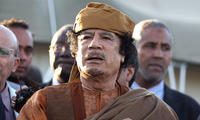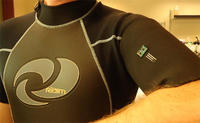-
U.S. troops deploy biometrics in the field
Biometric databases in Iraq and Afghanistan are helping U.S. troops combat violent insurgents; in an ambitious move, troops have sought to capture iris scans, facial photographs, and fingerprints from men of fighting age especially those who have been detained for insurgent or terrorist ties.
-
-
Qaddafi's Tripoli suicide plan

Libya’s prime minister confided in Russia’s envoy to Africa that Col. Qaddafi has a suicide plan for Tripoli if the rebels took over the city; the regime plans to shower the city with missiles and destroy it rather see the rebels control it; Libya has plenty of surface-to-surface missiles, and so far it has not used any of them against the rebels
-
-
Five years on: Israel-Hezbollah 2006 war

Five years ago today, a war broke out between Israel and Hezbollah after Hezbollah fighters made a foray into Israel, killing several soldiers and carrying the bodies of two of them back into Lebanon; despite the uneven scale of death and damage — Israel has inflicted much more damage on Hezbollah and Lebanon — the war was initially perceived as an Israeli defeat because Israel was unable to stop Hezbollah from firing rockets into Israel during the entire conflict; more recently, though, this initial conclusion has been revised somewhat, with some analysts pointing out that the Israel-Lebanese border has been quiet during the past five years — the longest period it has been so quiet; a respected Israeli military analyst says that the 2006 war was an Israeli failure — and unless Israel changes its definition regarding who the real enemy is, the next Israel-Hezbollah war will be and Israeli failure as well
-
-
Sensors printed on wetsuits detect explosives, other hazards

UC Sand Diego researcher has successfully printed thick-film electrochemical sensors directly on flexible wetsuit material, paving the way for nano devices to detect underwater explosives or ocean contamination; UCSD has a full U.S. patent pending on the technology, and has begun talks on licensing the system to a Fortune 500 company
-
-
New technology increase potency of beam weapons

Laser scientists and engineers have long recognized that direct-diode lasers can offer significant advantages over other laser technologies due to their efficiency, reliability, compactness, and relatively low cost; applications for direct-diode lasers have been limited, however, owing to their low brightness — a combination of lower power and poorer beam quality relative to alternative laser technologies; a Massachusetts-based company, using wavelength beam combining (WBC) technology, is offering a way to solve this problem — allowing direct-diode lasers to be used in demanding industrial applications — and in effective beam weapons
-
-
Key milestone for compact high-power laser

Enemy surface-to-air threats to U.S. manned and unmanned aircraft have become increasingly sophisticated, creating a need for rapid and effective response; one solution for countering these threats is high-powered lasers, which harness the speed and power of light to counter multiple — and rapidly approaching — threats; to be useful in combat, however, these lasers need to be lighter and require less space than current state-of-the-art for use on many of today’s air assets; DARPA is working to develop this compact laser
-
-
More borders, cheaper conflict steadily increase number of wars
New research shows that the frequency of wars between states increased steadily from 1870 to 2001 by 2 percent a year on average; the research argues that conflict is being fed by economic growth and the proliferation of new borders
-
-
House introduces new biological weapons legislation
Last Thursday lawmakers from the House Homeland Security Committee unveiled new legislation designed to help bolster federal efforts to prevent bioterror attacks and the use of other weapons of mass destruction.; under the proposed bill, a new special assistant to the president for biodefense would be created; the bill is called the “WMD Prevention and Preparedness Act of 2011” and Senator Joe Lieberman (I-Connecticut) says he plans to introduce a similar piece of legislation in the Senate soon
-
-
Israeli first responders hold mass missile attack drills
On Wednesday Israeli government officials, the military, emergency responders, local governments, and millions of civilians across the nation took part in a simulation of a simultaneous mass missile strike; the exercise has been held every year for the past five years but is unique in that it was the first time the entire population was asked to participate by seeking cover; in the simulation 7,000 missiles have rained down across the country and hundreds have been killed and thousands wounded; emergency responders practiced treating large numbers of casualties while school children practiced entering bomb shelters
-
-
Anytime, anywhere communications across all devices enhances collaboration

Connecticut-based company offers anytime, anywhere communications across all types of devices — allowing public safety, emergency response, and select critical infrastructure entities to communicate and collaborate in the event of an emergency; the system may also be used by the military — in the field thousands of miles away — to alert, and provide information to in real time, domestic emergency agencies
-
-
WWI, WWII-era dazzle camouflage of benefits in modern warfare

Warships in both the First and Second World Wars were painted with dazzle camouflage: startling geometric patterns aimed at confusing the enemy rather than concealing the vessel; while dazzle camouflage would probably not have successfully distorted ships’ speeds in the two World Wars, it could play a role in today’s battlefields where fast-moving army vehicles frequently come under attack from shoulder-launched, rocket-propelled grenades
-
-
Raytheon tests decoy drones
Raytheon reports it has successfully tested two Miniature Air Launched Decoy (MALD); MALDs will be sent into an area covered by an adversary’s air defenses — for example, those parts of Libya under Col. Gaddafi’s control; as the vehicle is noticed, the enemy’s radars light up, thus revealing their location and making it easier to destroy them
-
-
U.S. to receive Canadian radar feeds to combat drug smugglers
The Canadian government will soon start supplying DHS with data from its radar feeds to help border officials prevent low-flying airplanes from entering U.S. airspace to smuggle drugs along the northern border; in November the Canadian government will begin sending surveillance information collected from its twenty-two radar feeds to the U.S. Air and Marine Operations Center in Riverside, California; the data will be used to detect “unlawful entry into the United States”
-
-
Sophisticated new gadgets helped Navy SEALs take down bin Laden
In the daring raid that killed Osama bin Laden, Navy Seals were likely outfitted with latest in high-tech weapons and gadgets; Fox News speculates on five key technologies that could have helped the highly trained members of Navy SEAL Team 6 successfully complete their mission including bomb sniffing dogs, satellite-linked helmet cameras, and modified stealth Black Hawk helicopter
-
-
Smartphones offer investigators gigabytes of personal data

Unbeknownst to most smartphone users is the fact that investigators and criminals can access nearly every detail of a person’s private life just by gaining access to their phone; a forensic investigator can use a few simple tools to uncover a mountain of personal information including texts, photos, tweets, Facebook messages, emails, and important appointments; given the wealth of information that authorities are able to collect without a user’s knowledge, privacy advocates are not pleased; advocates are pushing for laws that regulate what type of information law enforcement officials can collect and what is off limits
-
More headlines
The long view
Bookshelf: Smartphones Shape War in Hyperconnected World
The smartphone is helping to shape the conduct and representation of contemporary war. A new book argues that as an operative device, the smartphone is now “being used as a central weapon of war.”
